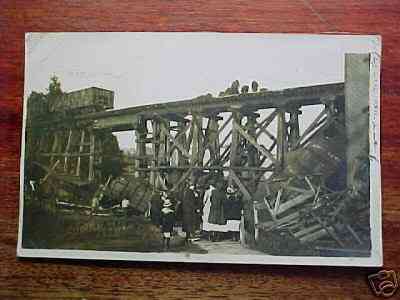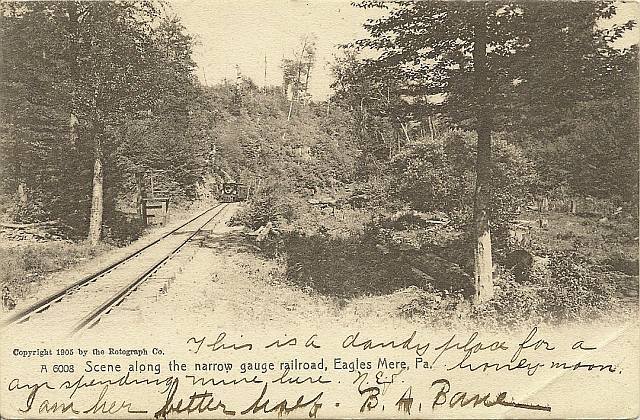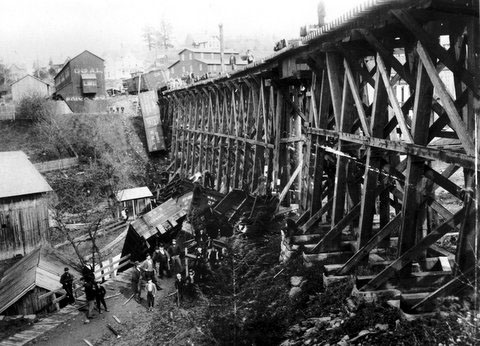
Dushore Train Wreck 1905
See Another Photo Below
Source: An old postcard auctioned on eBay in June 2007

Dushore Train Wreck 1905
See Another Photo Below
Source: An old postcard auctioned on eBay in June 2007
Naturally, over the course of several decades of train service in northern Pennsylvania, one would expect there to have been accidents and train wrecks. Such was the case. For example, at the end of the section on Railroads in Streby's Early Churches, Railroads, Towns, Businesses and Soldiers, there is a picture of a 1910 derailing near Satterfield. Here are two more anecdotes, one based on an acccident near Ringdale in 1905, the other occurring in Dushore itself in 1909.
October 2, 1980
Transcribed for the Sullivan County Genealogical Web Page
March 2005
Scattered accounts of the explosion of a Williamsport and North Branch locomotive at 7:25 p.m. EST on October 6, 1905 about one mile west of Ringdale, have appeared from time to time in various regional publications and newspapers.
Now, on the occasion of the 75th anniversary of this event, which some say was really October 5, we have collected a few more accounts of the accident.
Was it really an accident? Or, was it by today’s standards, something that was bound to happen according to some law of Murphy?
Nevertheless, it is known that the locomotive, No. 16, pride of the W & N.B. left Hughesville on that clear, nippy morning at 7:20 a.m. with Davy Davis at the throttle and Cleon Karshner doing the fireman’s job. Karshner was substituting for the regular man, who had “laid off” for the day. The regular man was John Anderson.
The engine, an American 4-4-0 arrangement, was a camel back style. That is the engineer was alone in the cab about halfway along the length of the engine. The fireman was at the rear of the engine, handy to the fire grate and the tender just behind. This engine built new for the W. & N.B. in 1893, had a wide firebox, designed to burn anthracite (hard) coal. Its cost was $10-12,000, no bargain, but a good passenger engine for the run between Hughesville and Towanda, a distance of about 60 miles by rail.
On the morning of its final run, No 16 had left Hughesville and proceeded to Halls Station. It then left Halls at 7:56 a.m. with a few passengers and the morning mail, came back to Hughesville and continued on to Towanda, where it arrived at 10:50. The northbound trip was train No. 525. The W. & N.B. passenger run to Towanda carried Lehigh Valley train numbers in the 500 series. This was done because LVRR was the predominant railroad, and even though it was W. & N.B. equipment, such numbers avoided confusing the dispatchers and ticket agents.
Of course stops were made at all the little stations along the right-of-way; Picture Rocks, Tivoli, Glen Mawr, Strawbridge, Beech Glen and Muncy Valley.
Then on to Sonestown, where it connected with a morning train to Eaglesmere which ran up the mountain on a narrow gauge track using a geared locomotive [Editor's Note: See photo below].
From Sonestown, No 525 went upstream along the Muncy Creek to Long Brook, where the engine stopped a few minutes to take on water from a tank located there.
Next station was Nordmont, which was located on the far side (north end) of a horseshoe turn, after an elaborate bridge, viaduct and stone arch were crossed. This arrangement of track got the train from one side of the gorge to the other.
Passengers and mail got on and off at each station, explaining why mail could be postmarked on leaving Nordmont in the morning and postmarked again that same morning upon arrival in Dushore.
Most of the northbound route was uphill to Satterfield (then Dohm’s Summit) but from there to Towanda it was a downhill so no real effort needed.
At Towanda by 10:50 a.m. E.S.T. the crew was hungry. No worry or hurry as they then had a layover until 5:30 p.m. when as train No. 526, the southbound run began.
A daily routine, the trip was uneventful as stops were made on time at Monroeton, South Branch, Stephenson, New Albany (arrived here at 6:08), Laddsburg, Dushore (6:23) Satterfield, Mildred (6:41), Bernice (6:45) and Ringdale (6:59), via Birch Creek Junction.
About 15 passengers were aboard the train, consisting of the engine No. 16, a baggage-mail combination car just behind the engine, a baggage-passenger combination car, and a full coach on the rear end.
Leaving the Ringdale station (maybe just a platform), Davy Davis eased the engine and cars to a stop at the Ringdale water plug just south of the village where Dutchman’s Run provided an ample supply of water for the engine. The water came down a raceway, through a trough to the tender, delivering about 3500 gallons of water in 10 to 12 minutes.
While flagman Arthur Bubb took care of the water, Karshner cleaned the grates and firebox and Davis, with his long spouted can, oiled the engine. Bubb didn’t have to do this job, but he did so to help the fireman and save time later on.
The train was scheduled to arrive in Laporte, the county seat, at 7:16 p.m. but was always late because of this routine at Dutchman’s Run. Besides the train had an hour’s layover at Sonestown and some time could be lost along the way. The layover at Sonestown was to make connection with a train coming down from Eagles Mere at 8:50 p.m.
As No. 16’s air pump was panting at the waterspout, Arthur Bubb’s hound dog was creating a problem in the baggage car howling or something so that Arthur instead of riding the cab on to Laporte as was his custom decided to ride the baggage car instead and comfort his dog.
At 7:25, three minutes after leaving the waterspout, No 16 exploded with a force so great that the lids were blown off a cook stove at the Karge farm almost a mile distant to the north across the Loyalsock Valley.
Baggage man William Wetherill and Conductor Bedell (Del) Edkin, reported later that they felt the train lurch and bounce as if it hit something. When forward motion was stopped they found the tender across the tracks perpendicular, and the engine on its side just clearing a hole big enough to bury a team of horses.
With lanterns they soon located Karshner in a ditch behind the tender seriously injured. Davis was blown about 500 feet forward of the engine and died as the crew located him again using lanterns.
Two more items of note. Among the passengers on the train was one Elroy Schwank, a repairman for a telephone company, returning to Williamsport. He happened to have his tool kit along and it was he who climbed a nearby pole tapped into the line and called the dispatcher in Hughesville to report the accident. The wires immediately to the side of the locomotive were sheared off, so a second pole down the line was used for the tap. Poles were located 250 feet apart.
The second item. On hearing the explosion, and after replacing the lids on her stove, Mrs. Karge (Sheriff Karge’s grandmother) grabbed a lantern, ran out of her house, down across the meadow to the Loyalsock Creek, forded the creek and walked or ran up the bank to the railroad grade. The distance was maybe close to a mile. Finding the crew around a bleeding Davy Davis, she tore off her petticoat and fashioned a tourniquet. But, unfortunately, the first aid was too late and Davis died shortly. It was reported that Mrs. Karge later received a lifetime pass for travel on the W. & N.B.
With the report of the accident in hand, the dispatcher at Hughesville commanded another W. & N.B. engine to prepare for an emergency run to the scene of the explosion. Hughesville doctors and undertakers were put on the special train, which raced on past Laporte, on to the place of the explosion arriving before 9 p.m.
The injured Karshner was put aboard, as were passengers and Davis, and the train backed down to Long Brook some 10 miles, where it was turned around on the wye. Headed south, the train went directly to Williamsport, using Reading Railroad tracks where Karshner was taken to the hospital. He died the following afternoon.
The clean-up operation didn’t take long. With the help of a Reading RR “big hook” the remains of No 16 were placed on a gondola and taken to the scrap yard. The hole was filled in and the track replaced.
In daylight the workers noted that the boiler crown sheet, at the time of the explosion, sheared off an eight-inch tree near the track. Parts of the engine were scattered over a wide area and some can now be found in the railroad museum at Strasburg, PA.
Early in 1906 the widows Davis and Karshner sued the railroad in the Lycoming County court in a claim based on negligence. The jury threw out the case or at least rendered no verdict, leaving the widows with nothing. Cleon Karshner left five children.
Reports at the time suggested the engine was not fit for service, that this and that was wrong with it. But no proof of this was ever substantiated, and testimony of the case was lost or destroyed when the new Lycoming County courthouse was built.
Resources for this article have been personal interviews,
notes taken by George Hart of the Railroad Museum of Pennsylvania and Tom
Taber’s book Muncy
Valley Lifeline.
Editor’s Note:
There was an accompanying photo to the preceding story. It was from the collection of
F.W. Corcoran, once secretary of the W. & N.B. and
loaned to The Sullivan Review by George M. Hart, but it was too hard to
scan from the newspaper source. However we do have a photo of the Eagles Mere Railroad track to which the train described above connected:

Eagles Mere Railroad
Narrow Gauge Track
The handwritten note signed by B. A. Bane and initialed by his wife
indicates they were
honeymooning in Eaglesmere when the card was mailed.
Source:
An old postcard auctioned on eBay in December 2011
Copyright on postcard says 1905. Photo submitted courtesy of Scott Tilden.
The second incident took place in 1905 and is informally described in a note written on the back of the postcard shown at the top of this
page. The card was postmarked in March 1909 from Dushore and addressed to Miss Ada Baker in Bloomsburg, PA. Here are the contents:
Here is the long promised view of the wreck I am sorry but this is the only view I could get in town. This view is taken from the
side of this trestle toward the find. Holcome's ware house hides two cars which lie in the creek am sorry
to have kept you waiting so long.
From Uncle Len

Lehigh Valley Railroad Trestle Accident
Dushore, PA 1905
Photo submitted
courtesy of Carol Brotzman.
Copyright © 2005 The Sullivan Review for content and Robert E. Sweeney for format and style. All Rights Reserved. Prior written permission is required from The Sullivan Review before this content can be printed or otherwise copied, displayed or distributed in any form, and from Robert E. Sweeney before the presentation shown here can be copied, framed or duplicated in any fashion. This is a FREE genealogy site sponsored through PAGenWeb and can be reached directly at ~Sullivan County Genealogy Project (http://www.rootsweb.com/~pasulliv)
Back to the The Sullivan County Genealogical Web Page